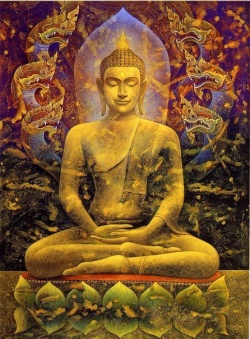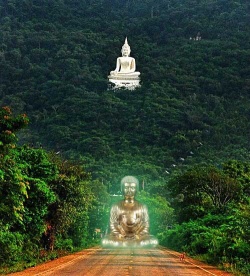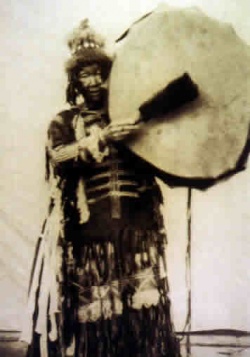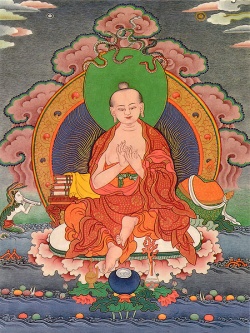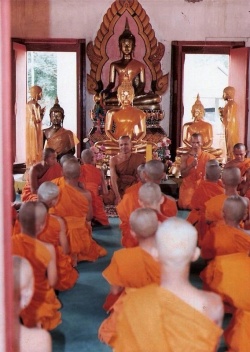The Buddha - The Seven Weeks After Enlightenment
The Buddha - The Seven Weeks After Enlightenment
by Ms Khema Goh
First Week
One posture sitting cross-legged and enjoyed the Bliss of Emancipation (Vimutti Sukha)
End of the week, during the first watch, the Buddha arose from the state of Concentration and thoroughly reflected on the “Dependent Origination” (Paticca Samuppada) in direct order.
Having perceived the meaning of this theory, the Buddha uttered forth this verse:
“When the truths become manifest to the strenuous,
meditative Brahmana then do all his doubts vanish away,
since he knows the truth together with its cause.”
Middle watch of the night, thoroughly reflected on the “Dependent Origination” (Paticca Samuppada) in reverse order.
Having perceived the meaning of this theory, the Buddha uttered forth this verse:
“When the truths become manifest to the strenuous,
meditative Brahmana then do all his doubts vanish away,
since he realised the cessation of causes.”
Last watch of the night, fully contemplated on the Cause and Effect of things both in their direct and reverse order.
Having perceived the meaning of this theory, the Buddha uttered forth this verse:
“When the truths become manifest to the strenuous,
meditative Brahmana then he dispels the forces of Mara,
and remains like the sun which illuminates the sky.”
Second Week
Remained one week gazing at the Bodhi tree with motionless eyes as a mark of profound gratitude to the inanimate Bodhi tree that sheltered him during his struggle.
Uneventful, but had silently taught a great moral lesson to the world.
Third Week
Certain deities resided at the Bodhi tree doubted His attainment to Buddhahood. To dispel their doubts, He created by His psychic power, a jewelled ambulatory (ratana camkamana) and paced up and down for a week.
Fourth Week
Created a jeweled chamber (ratanaghara)
Spent in the jeweled chamber contemplating the intricacies of the Abhidhamma (Higher Doctrine).
Mind and body were so purified when he pondered on the Relations (Patthana).
Seven treatise of the Abhidharma.
Six colored rays namely blue, yellow, red, white, orange and a mixture of these five colours emitted from His body.
Fifth Week
Enjoyed the Bliss of Emancipation under the Ajapala banyan tree.
Questioned by a conceited Brahmana on how one becomes a Brahmana and the conditions that make a Brahmana. Buddha’s reply:
“That Brahmin who has discarded evil,
without conceit (huhumka),
free from Defilements, self-controlled,
versed in knowledge and who has led the Holy life right,
would call himself a Brahmana.
For him, there is no elation anywhere in this World.”
Temptation by daughters of Mara – Tanha, Arati and Raga which was unsuccessful.
Sixth Week
Enjoyed Bliss of Emancipation under the Mucalinda tree.
Arose untimely a great shower with a cold storm.
Naga (Serpent) King Mucalinda came out of his abode, coiled round the Buddha’s body in seven tiers and kept his wide hood over the head of the Buddha to protect HIM from the elements.
End of week, Naga King gave up his form, and appeared before the Buddha as a young man, paid obeisance to Him.
Buddha gave utterance to this verse of joy:
“Happy is seclusion to him who is contented,
to him who has heard the truth,
and to him who sees.
Happy is goodwill in this world,
And so is restraint towards all beings.
Happy is this world is non-attachment,
The passing beyond of sense desires.
The suppression of the ‘I am’ conceit
Is indeed the highest happiness.”
Seventh Week
Enjoy Bliss of Emancipation under the Rajayatana tree.
During the last day, alms offered by two merchants, Tapassu and Bhalluka from Ukkala. This was his first meal after fasting for 49 days.
Two merchants were the first lay disciples of the Buddha by taking refuge in the Buddha and Dharma (Sangha was not in existence then).
They requested object of worship and was presented with some head hair from the Buddha.
Supernormal Knowledge or Vision:
1. Iddhividha – Flying through the air, walking on water, diving into the earth, creation of forms, etc. belonging to this category.
2. Dibbasota – is the Celestial Ear, also called clairaudience, which enables one to hear subtle or coarse sounds far or near.
3. Paracittavijanana – is the power to discern the thoughts of others.
4. Pubbenivasnussati – is the power to remember the past lives of oneself and others. This is the first supernormal vision of the Buddha developed during the first watch on the night He attained Enlightenment. With regard to this knowledge the Buddha’s power is limitless, while in the case of others is limited.
5.
(i) Dibbacakkhu – is the Celestial or Divine Eye, also called clairvoyance, which enables one to see heavenly or earthly things, far or near, which are imperceptible to the physical eye.
This was the second knowledge of the Buddha developed during the second watch on the night of His Enlightenment.
(ii) Cutupapatanana – knowledge with regard to the dying and reappearing of beings, is identical with this Celestial Eye.
(iii) Anagatamsanana – knowledge with regard to the future.
(iv) Yathakammupaganana – knowledge with regard to the faring of beings according to their own good and bad actions, are two other kinds of knowledge belonging to the same category.
These come within the range of Buddha’s Omniscience.
These five kinds of supernormal vision are worldly.
To these should be added the sixth supernormal knowledge.
6. Asvakkhayanana – knowledge with regard to the extinction of passions which is supramundane.
The first five kinds may be developed at any period; but the last only during the Buddha-cycle.
